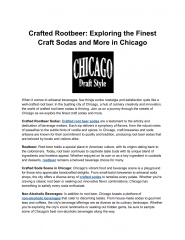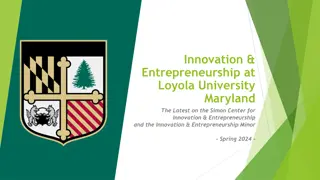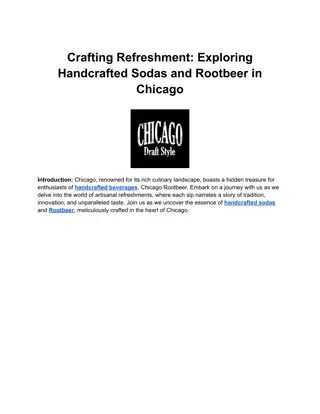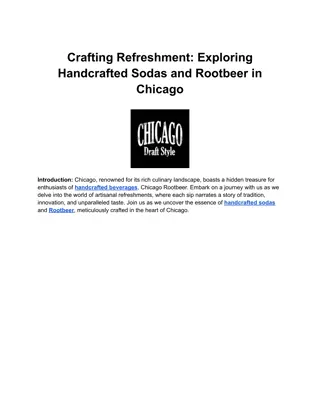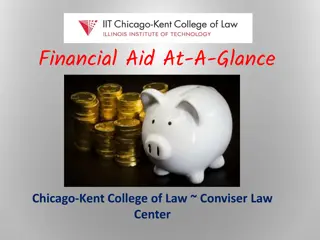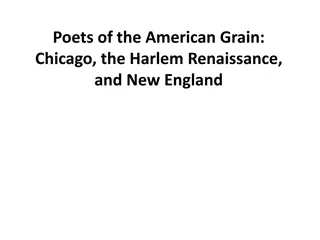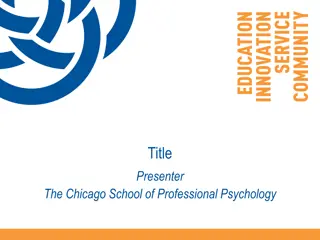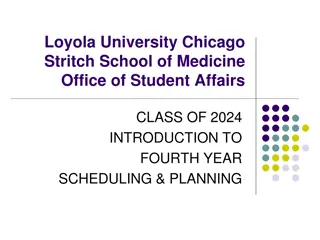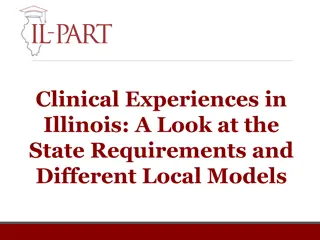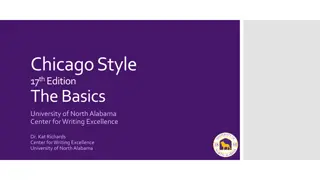
Challenges and Trends in Higher Education Transformation
Exploring the shifting paradigms in higher education, this content discusses the evolution from assessment for accountability to quality improvement and the current focus on quality assurance and learning outcomes. It delves into national and institutional contexts, highlighting issues such as rising costs, student debt, and the need for educational adaptation in a knowledge-based economy. The discourse also touches upon the quality of engagement and learning, potential backlash, and alternatives to traditional degrees in response to changing demographics and technologies.
Uploaded on | 0 Views
Download Presentation

Please find below an Image/Link to download the presentation.
The content on the website is provided AS IS for your information and personal use only. It may not be sold, licensed, or shared on other websites without obtaining consent from the author. If you encounter any issues during the download, it is possible that the publisher has removed the file from their server.
You are allowed to download the files provided on this website for personal or commercial use, subject to the condition that they are used lawfully. All files are the property of their respective owners.
The content on the website is provided AS IS for your information and personal use only. It may not be sold, licensed, or shared on other websites without obtaining consent from the author.
E N D
Presentation Transcript
August 16, 2012 Loyola University Chicago 1
Through a Different Lens: Teaching, Learning, and a New Role for Faculty Barbara Wright Vice President, WASC bwright@wascsenior.org August 16, 2012 Loyola University Chicago 2
The pendulum has swung . . . 1983-1990: heavy focus on assessment for accountability, ascertaining level of achievement 1990-2003: more focus on assessment for quality improvement, less on quality assurance 2003 present: renewed focus on quality assurance, standard-setting, comparability Most recently: urgency about quality of learning, retention and graduation rates, cost and debt May 6, 2010 CSHE 3
The national context . . . Boomers the most highly educated generation in US history retiring Replacement workers need higher educational levels for a knowledge-based global economy Federal investment (grants, loans) rising, results declining The education gap and ambition gap (Th. Friedman) put US at competitive disadvantage Prosperity, national security seen at risk Student debt the next bubble? May 6, 2010 CSHE 4
The institutional context . . . Falling state support Rising costs for students, the institution Struggles with student preparation, quality of engagement and learning Cumbersome transfer processes, waste Overbuilt, overextended institutions Diluted mission, arms race Potential for a populist backlash February 24, 2012 AAC&U 5
Gadfly, try not to tell too many people that you went to this school August 16, 2012 Loyola University Chicago 6
Is There a Quality Problem? Academically Adrift Wabash study NSSE data IHE survey of provosts Employer surveys National Assessment of Adult Literacy August 16, 2012 Loyola University Chicago 7
What else? A convergence . . . Demographics Disruptive technologies Tech-savvy students Availability of learning resources Student- and learning-centeredness Outcomes assessment Alternatives to traditional degrees The Degree Qualifications Profile February 24, 2012 AAC&U 8
Shifts in assessment our understanding of student learning assessment From To Scoring right, wrong answers Looking at the whole reasoning process Multiple methods & opportunities, e.g., open-ended tasks, projects, observations A single way to demonstrate knowledge, e.g. m/c or short-answer test Simplified evidence Complex evidence May 6, 2010 CSHE 9
Shifts in assessment, cont. A secret, exclusive & fixed process Open, public & participatory Reporting only group means, normed scores Disaggregation, analysis, feedback Psychometric Educative A pump A filter An add-on Embedded May 6, 2010 CSHE 10
Shifts in assessment, cont. Teacher-proof assessment Respect for faculty & their judgments Students as participants, beneficiaries of feedback Students as objects of measurement Ongoing, integrative, developmental Validity Episodic, conclusive Reliability May 6, 2010 CSHE 11
Shifts in assessment, cont. Isolated facts, skills A full range of knowledge, skills, dispositions Memorization, reproduction Problem solving, investigating, reasoning, applying, communicating Comparing performance to established criteria Comparing performance against other students May 6, 2010 CSHE 12
Methods appropriate for complex outcomes are direct are open-ended focus on essentials, principles pose authentic, engaging tasks require meaning-making, judgment require active expression are scored for understanding, not just regurgitation May 6, 2010 CSHE 13
Methods for documenting complex outcomes include Portfolios Capstones Performances Common assignments, templates Secondary readings Course management programs Local tests, comps in the major May 6, 2010 CSHE 14
The Assessment Loop 1. Goals, questions 4. Use 2. Gathering evidence 3. Interpretation August 16, 2012 Loyola University Chicago 15
Lets think about use. What if we have focused too much on closing the loop in OUR terms? What if our thinking has been much too limited? What if we think about use in terms beyond the limits of our experience and the campus? February 24, 2012 AAC&U 16
What else? A convergence . . . Demographics Disruptive technologies Tech-savvy students Availability of learning resources Student- and learning-centeredness Outcomes assessment Alternatives to traditional degrees The Degree Qualifications Profile February 24, 2012 AAC&U 17
The old business model of college and the great unbundling (Kamenetz) - Knowledge Instruction Validation of learning Degrees Social networking Cultural opportunities Personal development February 24, 2012 AAC&U 18
What if . . . the business model for HE is no longer sale of courses and credit hours but validation of learning? What are the implications for Students? Faculty? The curriculum? Administration? February 24, 2012 AAC&U 19
If we focus on outcomes, what is the role of courses? Of faculty? A student-centered institution shifts the emphasis from teaching to learning provides flexible timeframes, multiple pathways aims for mastery learning Learning is the end, courses a means Other paths can lead to learning, too, e.g., Open courseware Independent study Job training Avocations Assessment can validate learning from any source February 24, 2012 AAC&U 20
Assessment becomes the key to Diagnosing students strengths, weaknesses, levels of proficiency Validating acquisition of knowledge and skills Confirming fulfillment of degree requirements defined as outcomes Substantive communication Safeguarding quality And faculty are the front-line assessors. February 24, 2012 AAC&U 21
The students role changes . . . Greater freedom of choice Prior knowledge validated Transfer simplified Fewer formal courses needed Swifter degree completion, lower cost Greater personal responsibility Discipline, engagement required New skills essential February 24, 2012 AAC&U 22
The facultys work changes . . . Less focus on curriculum, courses Less classroom teaching More Advising, creating degree blueprints Diagnosing gaps in skills, knowledge Guiding study groups Devising tutorials, identifying resources Developing assessments Administering assessments Faculty development February 24, 2012 AAC&U 23
The administrators role ... Courage, leadership required Refocused mission, emphasis on learning Planning, budgeting, revenue affected Robust assessment infrastructure Collaboration with other institutions Transparency, accountability Engagement with public, policy makers February 24, 2012 AAC&U 24
Cautions and questions . . . Can students assume this responsibility? Will some be left behind? Will institutions be willing, able to change? Can assessment focus on results? Can faculty acquire new skills fast enough? Will policy makers support responsible change, avoid perverse incentives ? Will the public accept the change? What happens to the social role of HE social justice, equity, civic engagement? February 24, 2012 AAC&U 25
Why a new model for HE? To lower cost, improve access, raise quality of learning To use existing resources better To reach everyone s education goals To support US economy, security Because there may be no choice February 24, 2012 AAC&U 26
Assessment is the linchpin In the 20th century Improvement of learning Accountability In the 21th century Improvement & accountability plus Institutional transformation Institutional & national survival February 24, 2012 AAC&U 27
Sir, the following paradigm shifts occurred while you were out. August 16, 2012 Loyola University Chicago 28
August 16, 2012 Loyola University Chicago 29

